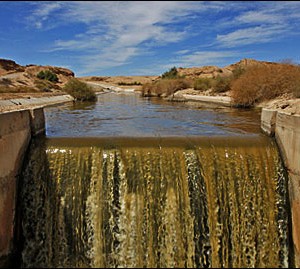Peter Gleick: Population and Water
Population discussions raise lots of hackles. And they bring the crazies out of the woodwork like termites when the Orkin Man appears. But I hope to post a series of pieces on population and water because we must stop ignoring the role of population in our environmental and water problems.
The amount of water on Earth is fixed. We’re not losing it to space and we’re not getting more (with negligible exceptions). The amount of water in a river basin or watershed is fixed. It goes up and down with natural variability, and it may change over time due to climate changes, but water is a renewable resources and our use of it does not affect the amount we get next year.
But population is not fixed. It is growing, and growing rapidly in some places. As a result, the amount of water available per person (“per capita”) is declining. Here is a simple example: assume that the average flow of water in a river basin is 10 million acre-feet per year and the population using that water is 20 million people. Then on average, the water available for use is around 450 gallons per person per day, if you could use it all (which would, of course, destroy the river ecosystem, but that’s another topic). If the population of the basin doubles to 40 million, the water availability per person drops in half, to around 225 gallons per person per day. If the population doubles again, water availability drops to just over 100 gallons per person per day.
The math is easy, but the consequences can be severe: abundance can become shortage. In simple terms, addressing water problems in the face of population growth come down to three choices: (1) increase the water supply, (2) decrease the water demand per person, or (3) change the number of people. Water policy in the past century focused only on increasing supply. Most of the work of the Pacific Institute has focused on the second because we believe the options for new supply in most places are increasingly limited, expensive, and environmentally damaging, and we see enormous potential for reducing demand. Almost no discussion, anywhere, focuses on the third choice. But the failure to address population in the long run will be disastrous. And the “long-run” is no longer so far away.
Water (Population) Numbers: While total water availability remains fixed, the population of the United States has grown from around 150 million in 1950 to over 305 million today. The population of California in 1950 was 10.5 million; today it is around 37 million. The population of the state of Georgia in 1950 was under 4 million; today it is approaching 10 million. The population of Jordan in 1960 was around a million; today it is 6 million. The population of Israel in 1960 was just over 2 million; today it exceeds 7 million. The population of Iraq in 1960 was around 7.3 million; today it exceeds 31 million.
Is it any wonder that California’s, or Georgia’s, or the Middle East’s water problems have worsened?
In a recent paper, Richard Seager of Columbia and his colleagues analyzed the recent drought in the southeastern United States. This drought led to water use restrictions, depleted flows in the major river basins of the region, and growing political tensions over water sharing between Georgia, Alabama, and Florida. The authors of this paper concluded that the recent drought in the Southeast was not climatologically different from past droughts, but was felt more severely largely due to the growth in population in the region. In July, a Federal judge ruled that Atlanta had to fundamentally change the way it obtains its water, and noted that
“Too often, state, local, and even national government actors do not consider the long-term consequences of their decisions. Local governments allow unchecked growth because it increases tax revenue, but these same governments do not sufficiently plan for the resources such unchecked growth will require. Nor do individual citizens consider frequently enough their consumption of our scarce resources, absent a crisis situation such as that experienced in the ACF basin in the last few years. The problems faced in the ACF basin will continue to be repeated throughout this country, as the population grows and more undeveloped land is developed. Only by cooperating, planning, and conserving can we avoid the situations that gave rise to this litigation.” (emphasis added)
Climate change is going to cause serious impacts on water resources, but even without it, we are running up against water constraints that will worsen if we continue to ignore the population elephant in the room.
More to come.
Peter Gleick
Dr. Gleick’s blog posts are provided in cooperation with the SFGate. Previous posts can be found here.











Dr. Gleick,
Thank you for this article. 4 years ago, when I was trying to figure out my PhD project, I wanted to go with water, population growth, population control. My committee’s reaction: I don’t think so. They told me it was a difficult and controversial subject and it should be left for a post doc. I was surprised and very disappointed, because I could not see a more important subject.
But really, it is simple math. Maybe it is so obvious that it would not be a valid thesis? I hope now that I am done I will be able to work on this subject.
I don’t know if my last comment was posted but I do not think the math is as easy as you think. State planning boards review local comprehensive plans in terms of land use (how much land is needed to support a growing and higher consuming population). Often this is a legislated process that is less than coordinated. Coordination in some states only begins after growth has been accounted for/planned for. Land needs is confused with land wants. As we all know, fresh water flow can be diverted via land use changes with the destruction of wetlands or the concentration of population in one area where water supply can become scarce. It is not to say population should be ignored but it should not be the primary basis upon which land use should be controlled within a given locality. It is true the fifth amendment has much sway on how much control a local or state govt can have. Growth should not be diverted into certain places. Nevertheless, using population projections as the basis of local government comp plan review is not optimal for the water lovers of the world over space and time. There should be more coordination with water managers and land use planners if the judges commentary on conservation and planning is going to work. A spatial mismatch of water related problems will be recurrent if this is continually ignored by states. How else do you explain interbasin (i mean within the state) transfers occurring nowadays the south?
I don’t know about local levels , but in the end, we need start adressing this in a global, long-term planning manner. It is a difficult subject, but I think it is time.
of course I agree with you…especially if you consider global trade and how most people do not know where the stuff they consume comes from. however, i dont see certain states agreeing with you so quickly.